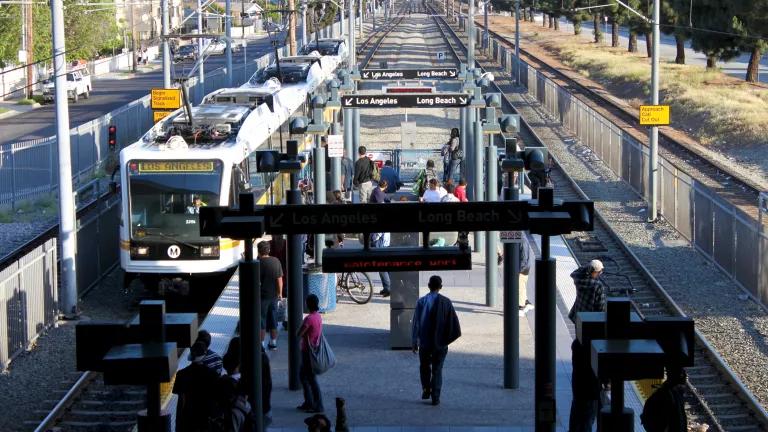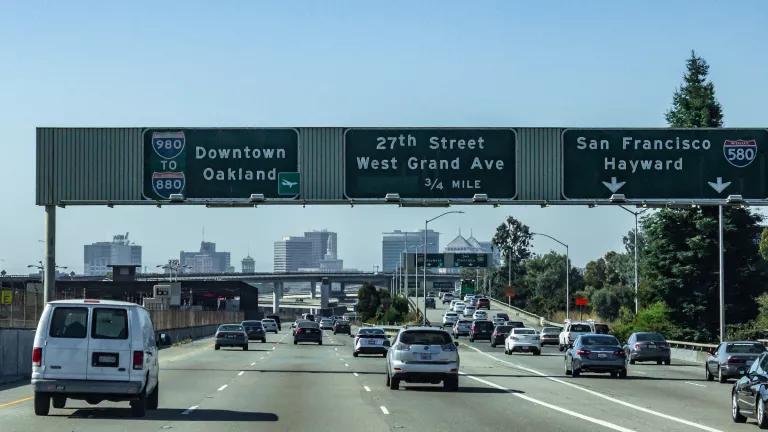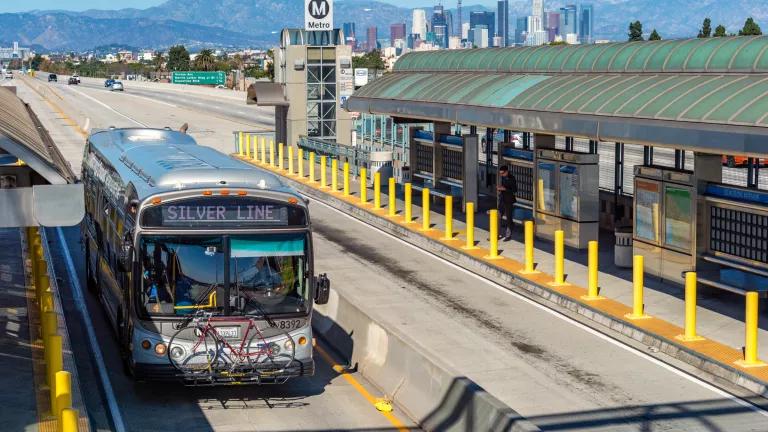California Has Led on Policy—Now Time to Deliver on Climate and Equity
New NRDC research highlights California’s transportation and climate policy leadership, following another recent NRDC report highlighting implementation gaps

A Blue Line Metro train arriving at Imperial-Wilmington station in Los Angeles, California
California takes the top spot in a new state transportation scorecard released by NRDC. The report evaluates transportation policy and spending in all 50 states to understand how federal funding from the bipartisan infrastructure law and Inflation Reduction Act are likely to influence the clean transportation landscape. California has led the way nationally with clean vehicle standards and taken pioneering legislative and executive action intended to align land use and transportation investments with climate goals.
States are scored across 20 metrics related to state planning for climate and equity, vehicle electrification, expanding transportation choices, system maintenance, and procurement. This national ranking shows the strength of the state’s policy leadership, with California scoring 86.9 points out of 100.
Still, all the promising, thoughtful, and well-intentioned policy in the world means little until it is able to deliver real benefits to communities suffering from some of the worst-in-the-nation diesel pollution, to people stuck in traffic and struggling to make car payments, or to those who have been directly displaced or had their communities and ecosystems divided by costly and ineffective highway expansions. As another recent NRDC analysis shows, the State of California—to say nothing of the local and regional projects that the state directly or indirectly supports—still allocates 80 percent of its own transportation spending to preserving or worsening this polluting, unjust, and misguided status quo.
Until these and problematic local spending practices are structurally reformed, California’s leaders will still have their work cut out for them to show a viable path to ensuring that all of California’s communities can travel safely and affordably while breathing clean air. Thankfully, shifting investments away from wasteful, polluting highway expansion projects and toward clean, affordable mobility choices is also likely to increase direct job creation by 30 percent, even before considering the permitting of new housing developments with high-road job requirements that can now be triggered under California law when new major transit stops are built—creating a virtuous cycle of clean mobility investment, affordable housing construction, and high-road job creation.
California lights the way with ambitious vehicle standards and policies aligning land use and transportation planning with climate goals
California has adopted an important set of clean transportation policies to address rising transportation-related greenhouse gas emissions that often serve as a precedent for actions at the federal level. Nowhere is this more clear than in the zero-emissions vehicle space, where California literally sets the standard for best-in-class zero-emission vehicle (ZEV) policies, not just in the United States but internationally. The state has pioneered the Advanced Clean Cars, Advanced Clean Trucks, and more recently Advanced Clean Fleets rules to light the way to eliminating tailpipe emissions across the light-, medium-, and heavy-duty vehicle sectors. To complement these manufacturer and fleet requirements, California provides ZEV purchase incentives, including rebates targeting low-income buyers and allow for the purchase of used vehicles. Lastly, California has more fast charging ports than any other state to support the anticipated ramp up in electric cars and trucks—with more on the way.
California was an early leader in coordinating land use and transportation planning with climate goals. Senate Bill 375, passed in 2008, requires the California Air Resources Board (CARB) to set regional targets for greenhouse gas emissions and requires regional planning entities to align their plans with those targets. Recent laws have strengthened these policy incentives by allowing more infill housing development and eliminating minimum parking requirements near high-quality transit stops. Under the banner of the Climate Action Plan for Transportation Infrastructure (CAPTI)—initiated by Governor Newsom’s ambitious Executive Order N-19-19—the state has also increasingly incorporated climate and equity into transportation funding programs through updated project scoring processes. These reforms have directly led to promising (albeit insufficient) shifts away from polluting and ineffective highway expansion projects, as both recent NRDC analysis and the State’s new draft CAPTI implementation report highlight.
The Golden State is also a national leader in spending flexible federal transportation dollars on public transit projects that promote affordability and clean air, shifting a significant share of eligible ‘highway’ dollars into eligible transit funding programs. Yet this leadership in shifting how funds are spent is not driven by state agencies, but rather by a small handful of local agencies and regional planning entities like Los Angeles County’s Metro and the Bay Area’s Metropolitan Planning Commission. In other words, the State itself is not leading the way—but rather giving funds to local governments, some of whom have been more willing to lead. Other states would do well to pass more federal funding onto local governments specifically to support clean transportation investments, though that’s no excuse for state transportation departments, Caltrans included, to continue prioritizing their own spending on wasteful and polluting highway boondoggles.
In spite of policy progress, California lags on pollution reduction—highlighting a need for continued state transit investments and life-saving traffic safety improvements
Despite this promising policy leadership, Californians remain stuck in traffic and overwhelmingly breathing polluted air: The transportation sector is responsible for a whopping 38 percent of the state’s greenhouse gas emissions. Repeated research authored by a growing list of California state agencies—in addition to recent research by NRDC and by NextGen Policy—shows that critical shortcomings remain in the state’s transportation policy and funding landscape.
In this new scorecard analysis, California’s efforts to reduce driving (measured in terms of “vehicle miles traveled”, or VMT) show the greatest need for improvement. The state scores just 25.8 points out of an available 34 in this category, with notable gaps in both state transit investment (1 out of a possible 5 points) and safety for the most vulnerable road users (i.e., people walking or riding a bicycle). California has increased investment in transit in recent years, a promising trend that is not captured in the scorecard’s 2018-2020 analysis period. With respect to the safety metric, California scores 1.8 out of a possible 4 points, good for second-worst among the top 10 performing states (in the most recent state-provided traffic safety statistics from 2021, deaths on California’s roads increased 7.6 percent in a single year, to more than 4,200)—showing a need for Caltrans leadership to recommit to implementing existing road safety and complete streets policies that have not yet realized their intended impact.
California has some of the country’s most ambitious emissions reductions goals in place, as outlined in the California Air Resources Board’s Scoping Plan, which concludes that an extraordinarily ambitious 25 percent reduction in driving by 2030 would be necessary to keep our state on track to meeting its climate goals.
The investments necessary to enable Californians to drive less by walking, biking, and taking transit more have not been prioritized and, as a result, California’s transportation funding ecosystem still props up wasteful highway capacity projects. Among these are the Sacramento region’s I-80 expansion (which has come under increased scrutiny following recent whistleblower reports alleging misuse of state funds and intentional evasion of California’s environmental protection laws) and State Route 37 in the Bay Area, which is being widened with a more-than-$400 million investment in spite of the fact that it is forecast to be largely underwater due to sea-level rise within roughly a decade of project completion.
California must accelerate emissions reductions from freight, especially in environmental justice communities
Eliminating emissions from heavy-duty vehicle traffic and the freight sector is important from a climate perspective but even more so because of the environmental injustice and disproportionate health impacts caused by diesel pollution from freight traffic. Because of data availability limitations across all 50 states, these burdens—which are particularly acute in California’s Central Valley, Inland Empire, and around the Ports of Los Angeles and Long Beach—are not carefully considered in this national scorecard. The scorecard focuses on on-road transportation (omitting shipping, for example) and with respect to freight only evaluates adoption of the Advanced Clean Trucks standard that California pioneered.
California has gone beyond Advanced Clean Trucks this year by passing the first-of-its-kind Advanced Clean Fleets standard, adding to a growing list of policies championed for decades by environmental justice advocates. Urgency and accountability in these policies’ careful implementation is critical to advancing climate and pollution reduction goals, but more importantly is a matter of life and death for Californians living with freight pollution—in Los Angeles County, for example, residents of port-adjacent communities suffer from disproportionate rates of asthma and have life expectancies that are 8 years shorter than other LA County residents on average.
California has an opportunity to advance its pollution-reduction leadership on multiple fronts in 2024
While California has adopted a wide range of transportation policies to address transportation emissions and rises above its peers in NRDC’s new transportation scorecard, the state must turn its attention to equitable implementation and accountability to ensure that these policies begin living up to their as-of-yet unrealized promises of clean air, traffic safety, and equitable transportation outcomes. Transportation remains the single biggest source of carbon emissions in the state (as it is in the United States more broadly), and other states and national leaders will continue to look to California for leadership. It’s up to California’s elected leaders to make sure these policies aren't just talk but drive action.
California leaders have several imminent opportunities to demonstrate their commitment to improving outcomes in the communities who have been most-impacted by unjust transportation investments and transportation pollution:
- Advance and champion new legislative proposals that structurally align state spending with California transportation agencies’ climate, equity, safety, and job creation priorities
- Full commitment to implementing both the spirit and letter of the state’s Senate Bill 743, which aligns California Environmental Quality Act analysis with science-based best practice, by ensuring full mitigation of induced VMT impacts for all proposed highway capacity projects
- Proactively and swiftly addressing concerns raised by more than 100 organizations in California and nationally in response to troubling whistleblower allegations and a steady drumbeat of state analysis showing slower-than-necessary progress
- Updating CAPTI in 2024 to continue implementing Governor Newsom’s Executive Order N-19-19, building on prior progress with pointed attention to administratively aligning state and local spending with climate, equity, and safety goals, including by adopting strong, consistent quantitative project scoring metrics via the California System Investment Strategy; and by improving transparency in planning and spending through the expedient implementation of the newly signed-into-law SB 695




